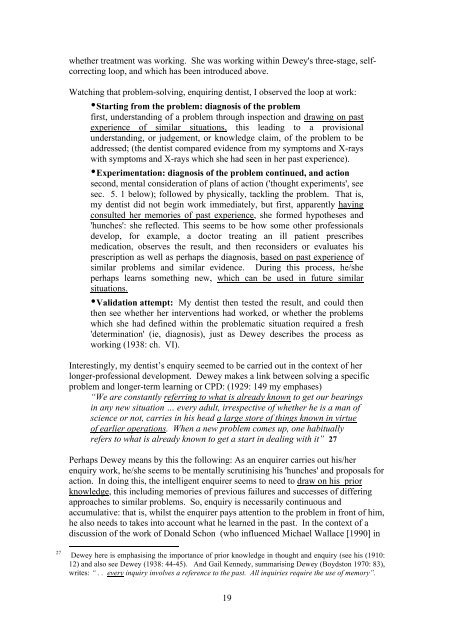RADICAL TEFL
2hqhXJd
2hqhXJd
Create successful ePaper yourself
Turn your PDF publications into a flip-book with our unique Google optimized e-Paper software.
whether treatment was working. She was working within Dewey's three-stage, selfcorrecting<br />
loop, and which has been introduced above.<br />
Watching that problem-solving, enquiring dentist, I observed the loop at work:<br />
• Starting from the problem: diagnosis of the problem<br />
first, understanding of a problem through inspection and drawing on past<br />
experience of similar situations, this leading to a provisional<br />
understanding, or judgement, or knowledge claim, of the problem to be<br />
addressed; (the dentist compared evidence from my symptoms and X-rays<br />
with symptoms and X-rays which she had seen in her past experience).<br />
• Experimentation: diagnosis of the problem continued, and action<br />
second, mental consideration of plans of action ('thought experiments', see<br />
sec. 5. 1 below); followed by physically, tackling the problem. That is,<br />
my dentist did not begin work immediately, but first, apparently having<br />
consulted her memories of past experience, she formed hypotheses and<br />
'hunches': she reflected. This seems to be how some other professionals<br />
develop, for example, a doctor treating an ill patient prescribes<br />
medication, observes the result, and then reconsiders or evaluates his<br />
prescription as well as perhaps the diagnosis, based on past experience of<br />
similar problems and similar evidence. During this process, he/she<br />
perhaps learns something new, which can be used in future similar<br />
situations.<br />
• Validation attempt: My dentist then tested the result, and could then<br />
then see whether her interventions had worked, or whether the problems<br />
which she had defined within the problematic situation required a fresh<br />
'determination' (ie, diagnosis), just as Dewey describes the process as<br />
working (1938: ch. VI).<br />
Interestingly, my dentist’s enquiry seemed to be carried out in the context of her<br />
longer-professional development. Dewey makes a link between solving a specific<br />
problem and longer-term learning or CPD: (1929: 149 my emphases)<br />
“We are constantly referring to what is already known to get our bearings<br />
in any new situation … every adult, irrespective of whether he is a man of<br />
science or not, carries in his head a large store of things known in virtue<br />
of earlier operations. When a new problem comes up, one habitually<br />
refers to what is already known to get a start in dealing with it” 27<br />
Perhaps Dewey means by this the following: As an enquirer carries out his/her<br />
enquiry work, he/she seems to be mentally scrutinising his 'hunches' and proposals for<br />
action. In doing this, the intelligent enquirer seems to need to draw on his prior<br />
knowledge, this including memories of previous failures and successes of differing<br />
approaches to similar problems. So, enquiry is necessarily continuous and<br />
accumulative: that is, whilst the enquirer pays attention to the problem in front of him,<br />
he also needs to takes into account what he learned in the past. In the context of a<br />
discussion of the work of Donald Schon (who influenced Michael Wallace [1990] in<br />
27<br />
Dewey here is emphasising the importance of prior knowledge in thought and enquiry (see his (1910:<br />
12) and also see Dewey (1938: 44-45). And Gail Kennedy, summarising Dewey (Boydston 1970: 83),<br />
writes: “ . . every inquiry involves a reference to the past. All inquiries require the use of memory”.<br />
19


